Check Building Envelope
We are all familiar with the check engine light in our car. The reasons for a check engine light turning on can range from something minor like a loose gas cap to something more serious like a faulty catalytic converter. If you ignore the light, you do so at your own peril and it could lead to serious damage to your vehicle. Perhaps a check building envelope light can be developed to assist facility managers. Until that time comes a systematic approach to building envelope inspections should implemented. Based on what those inspections reveal scheduled preventative maintenance of the roof and exterior wall systems should happen.
When to inspect?
It is generally recommended that a thorough inspection of the building envelope be done at least twice per year. In northern climates where winter weather conditions can be harsh it is best to schedule one of these inspections in the early spring. It is also prudent to inspect a building after severe storms or other unusual weather events.
Why inspect?
A good inspection will reveal signs of deterioration or failure. By repairing any minor problems that are identified before they become major issues, a facility manager can extend the life of building components and avoid or delay costly major capital expenditures.
Small Repairs pay big dividends.
Small defects in the building envelope can allow water to infiltrate the buildings systems. If allowed to continue unabated roof insulation can become saturated, steel decks can corrode, wall components can fail.
According to the National Roof Contractors Association roof system maintenance is often the most neglected area of a roof management program. It’s also the single most important factor (after proper installation) for determining the life span and cost of a roof system.
So, with Spring upon us it is time to get out and inspect the roof and the walls of your building. Then schedule any repairs necessary to save you significant amounts of money and headaches in the future.


